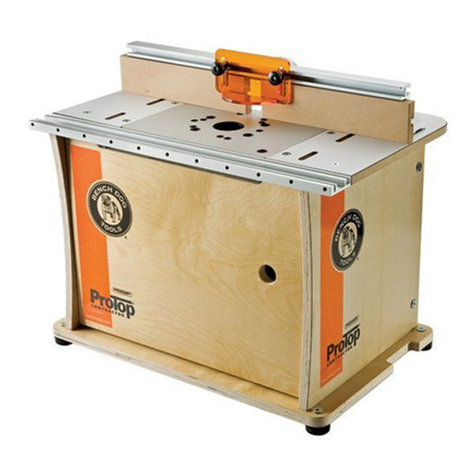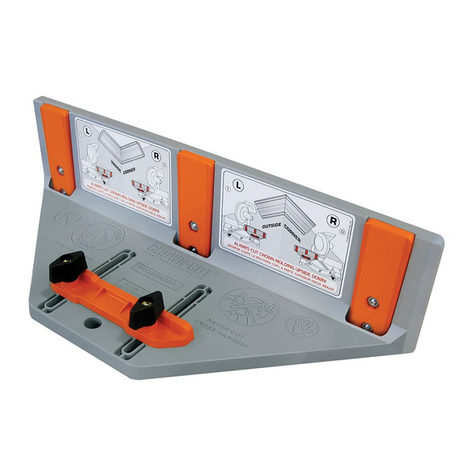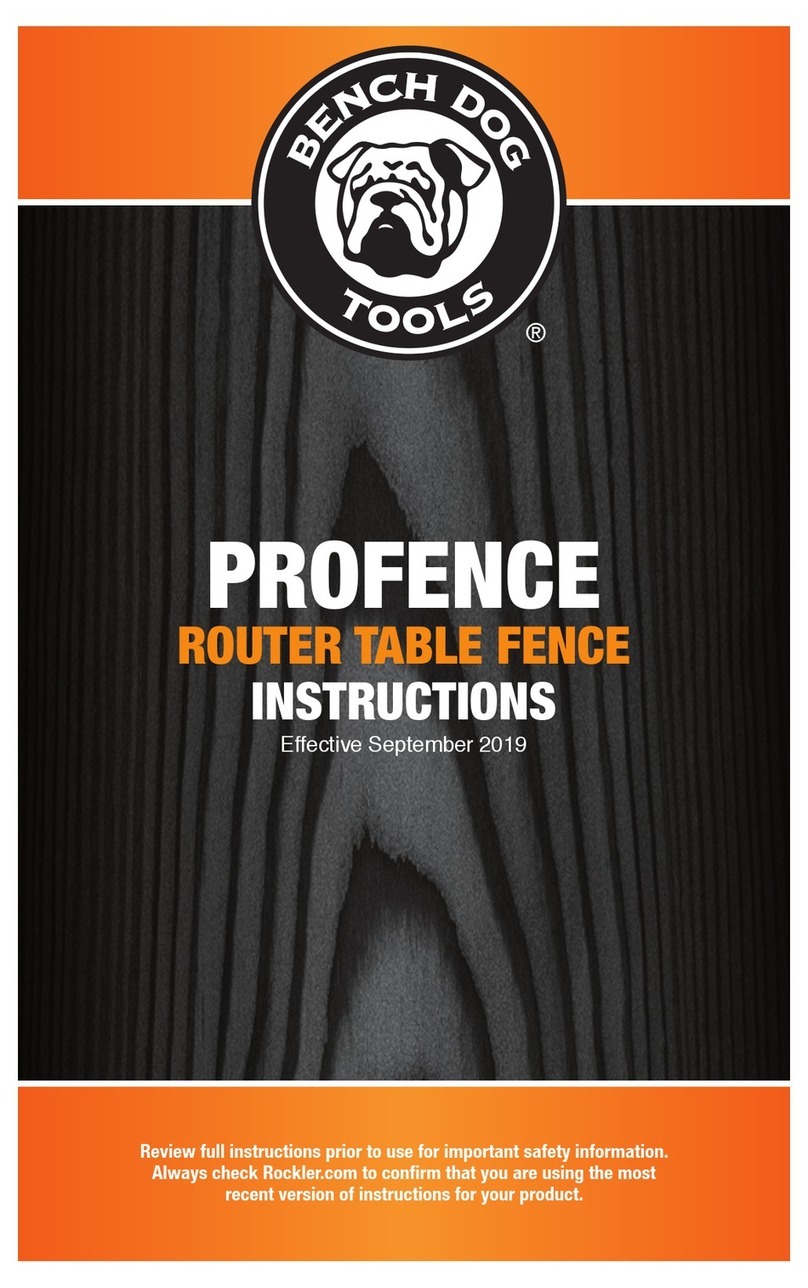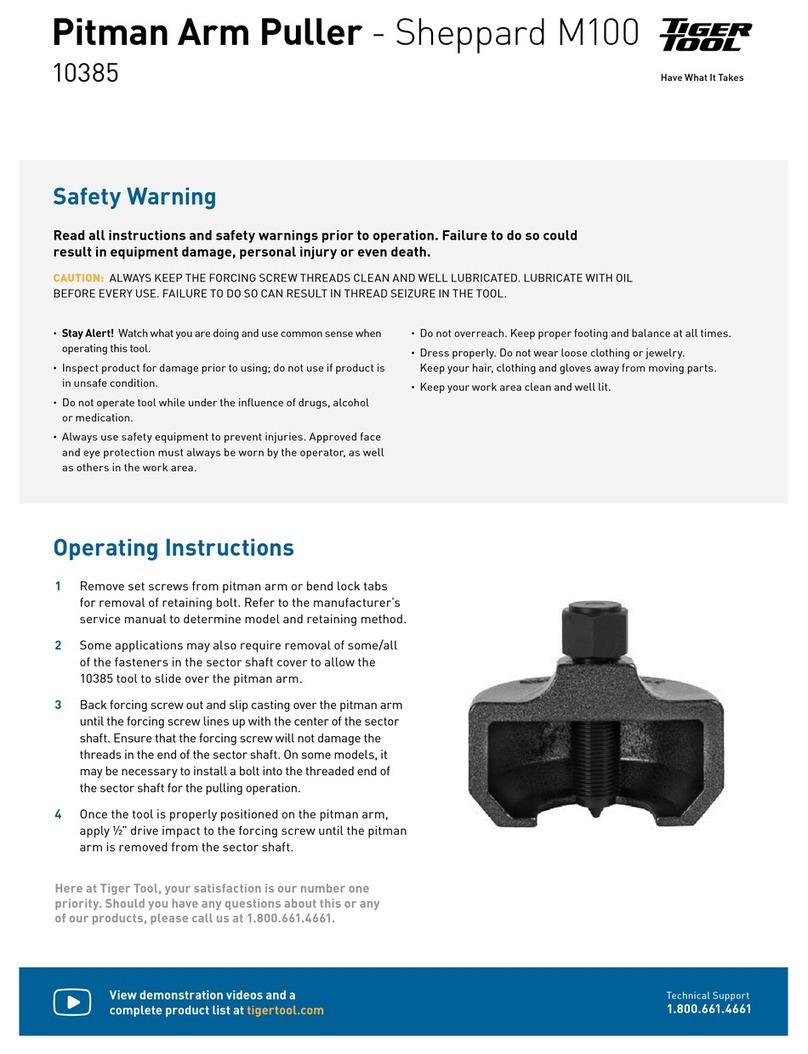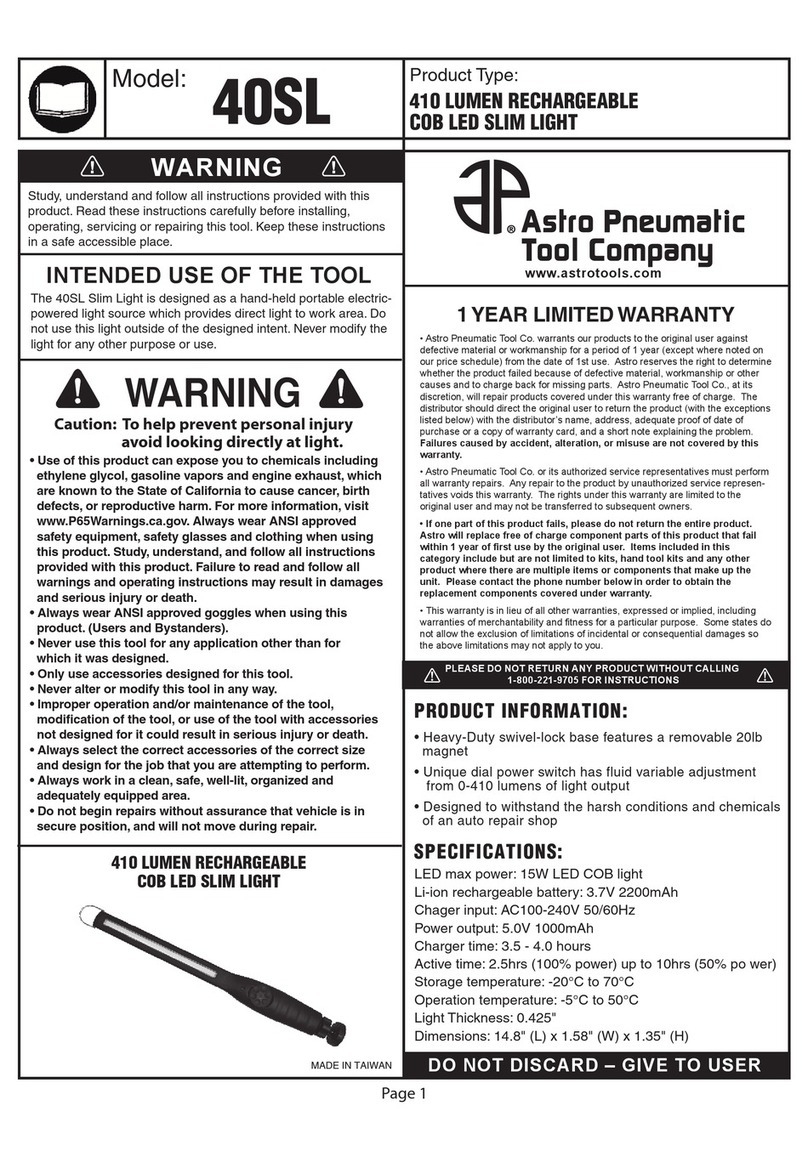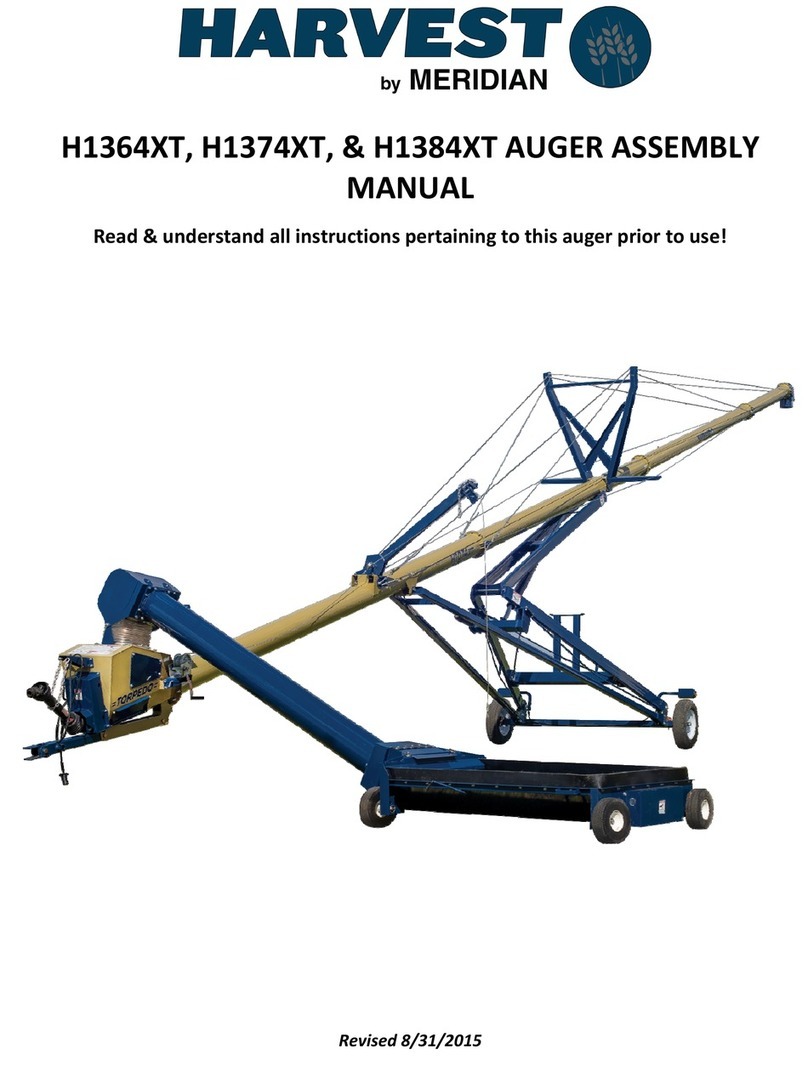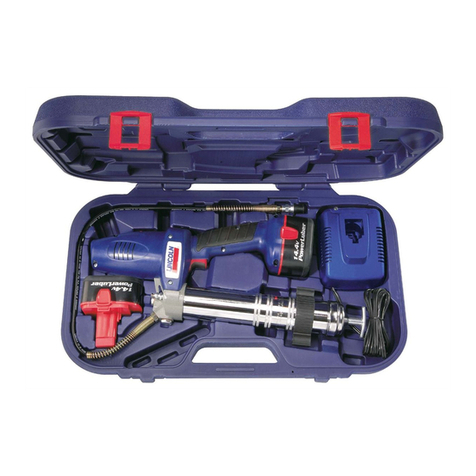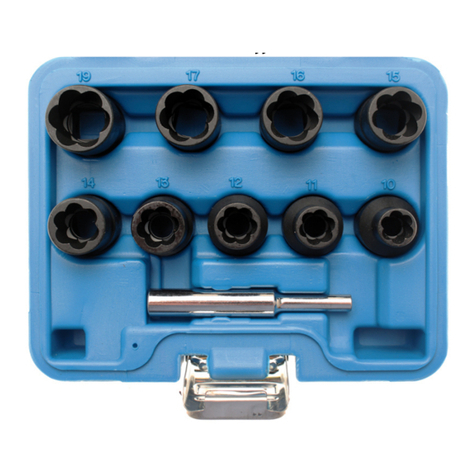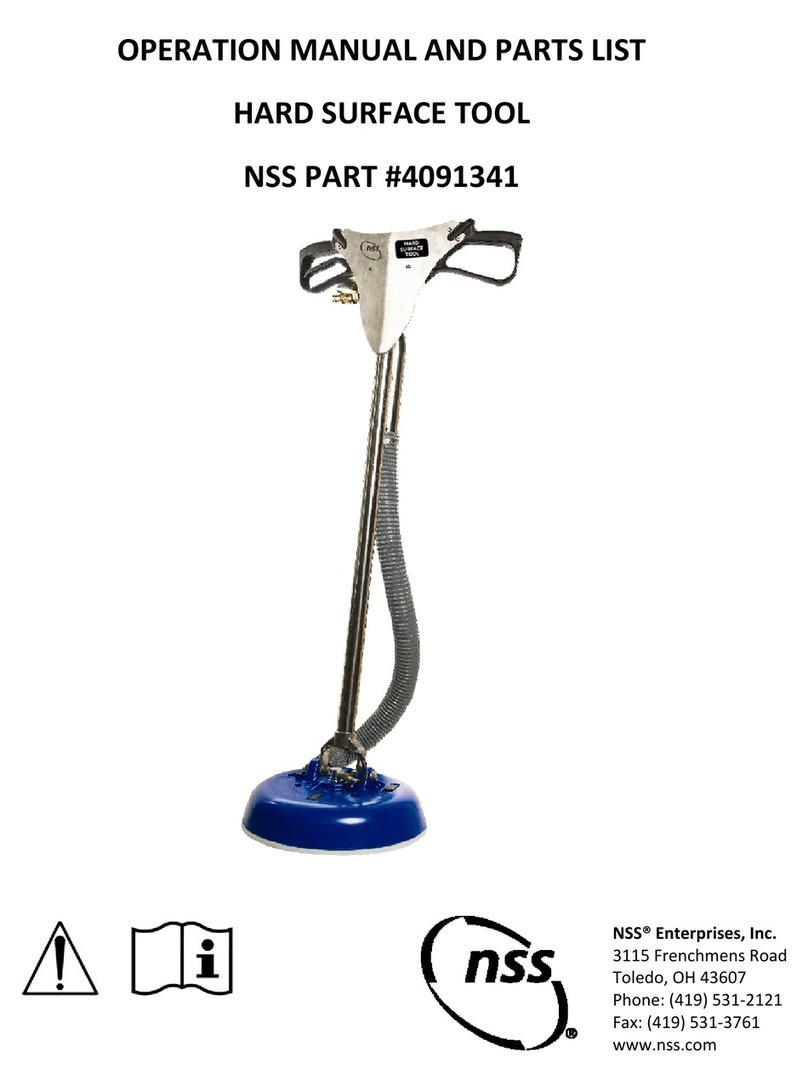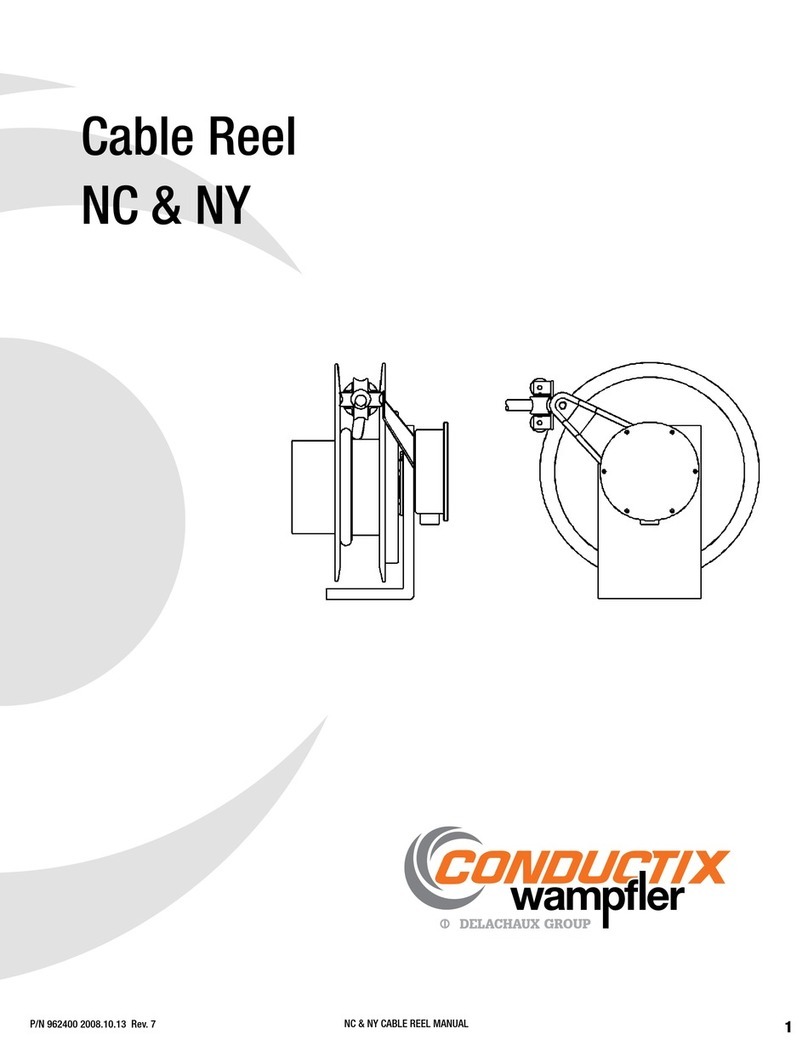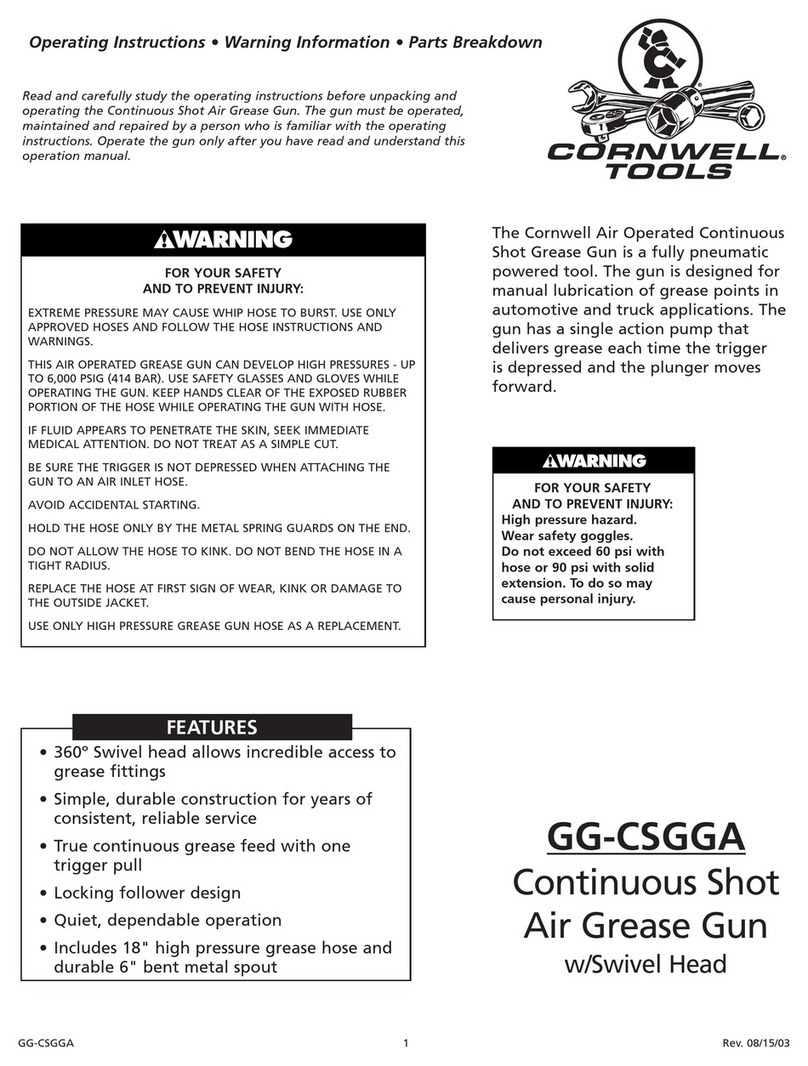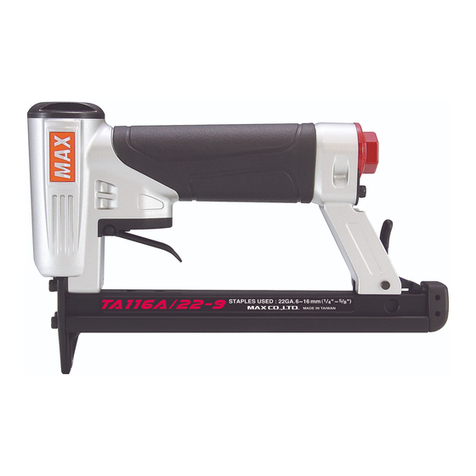Bench Dog Tools ProMax User manual


2
1 Cast Iron Router Top 1
2 Heavy Rectangular Washers 3
3 M10 x 11⁄2x 40mm Hex Bolts 3
4 7/16-20 x 11⁄2" Hex Bolts 3
5 5/16-18 x 11⁄2" Hex Bolts 4
6 5/16" Flat Washers 8
TABLE PARTS LIST
Quantity Quantity
7 5/16" Lock Washers 4
8 5/16" Hex Nuts 4
9 1/4-20 x 1" Leveling Screws 10
10 1/4-20 Leveling Hex Nuts 12
11 J Hooks 2
9
5
3
4
268
7
1
10
11
Note: Heavy Rectangular
Washer (2) must be
positioned on bottom
of table as shown.

3
1Aluminum Fence 1
2Adjustable MDF Fence Faces 2
3Bit Safety Guard 1
4Dust Port 1
53/8-16 T-Knobs 2
65/16-18 x 11⁄4" T-Bolts 6
71" Round Knobs 6
8Knob Spacer 2
93/8-16 x 21⁄2" Hex Bolts 2
10 3/8" Nylon Washer 2
PROFENCE PARTS LIST
Quantity
7
3
8
9
6
4
5
1
2
5
9
18
10
Table Top
Follow this diagram to attach the
fence to the table.
2
7
9
10

4
Attaching the Table
The following instructions only apply to
mounting the ProMAX directly to a cast
iron table saw. The pictures show a Delta
brand table saw, but the ProMAX will fit on
any cast iron table saw with at least 27" of
depth. Tables deeper than 27" will require
shims to fill the space between your fence
rails and the ProMAX.
Note: ProMAX cannot be installed as a left
extension replacement on left tilt “cabinet”
grade table saws because the table saw's
motor protrudes to the left. Nor can
ProMAX be installed as a right extension
replacement on right tilt “cabinet” grade
table saws for the same reason. Mounting
ProMAX to the far right will avoid the
protruding motors, however, ProMAX
must be supported with the two steel rails
that also support your T-square style rip
fence and legs.
1. Remove the factory left
extension wing. Fig. 1.
Use the hardware that came with your
ProMAX to install your router table.
Do not use the factory bolts, as they
may not be grade 5 or the proper
length. If the necessary bolt size is not
supplied with this router table you
must purchase your own grade 5 bolts.
In most cases the fence rails support
the factory table extension wings.
When bolted directly to your table
saw, ProMAX requires no support
from the fence rails. Therefore, fence
rails do not need to be fastened
to ProMAX.
2. Determine your saw’s bolt pattern.
Craftsman and Ridgid use a four bolt
pattern. Almost all other saws use a
three hole pattern. Fig. 2.
3. Four hole applications:
Most four hole patterns use 5/16
bolts. Use the heavy rectangle washers
for the middle two holes as shown in
Fig. 3. Each bolt receives two 5/16"
flat washers, one lock washer, and
one nut. Late model Ridgid saws use
5/16-18 tapped holes instead of
through holes. If the bolt size is not
5/16-18, you must supply your own.
Use grade 5 bolts.
Fig. 1
Fig. 3
Fig. 2
3
4
3
4
3
44
Use heavy washers on
middle holes.

5
Fig. 6
Fig. 5
Fig. 4
Use heavy washers on all
three holes.
4. Three bolt applications:
This pattern always uses the heavy
rectangle washers on each bolt as
shown in Fig. 4. Delta brand uses the
7/16-20 x 11⁄2" hex bolts. Most others
(imports) use the M10 x 1.5 x 40mm
hex bolts. If your bolt size was not
mentioned you must purchase your
own. Only use grade 5 bolts.
6. Lift the router table into position.
Install the bolts while a friend holds
the table in position as shown in
Fig. 5. Just snug the bolts for now.
Make absolutely certain both surfaces
are smooth, flat, and free of burrs
before mating the two tables together!
7. Tighten the router table.
Tighten the bolts gradually and evenly
as shown in Fig. 6. Use a soft tipped
mallet to lightly tap the table surfaces.
If your router table is not flat with
your table saw’s table, you may need
to shim it. Use paper or brass shims.
The tolerances of your ProMAX are
probably much higher than those of
your table saw’s. Slight inaccuracies
in alignment rarely pose a
significant problem.
Note: The plate opening on your ProMAX
is sized to accommodate a Bench Dog
ProPlate (sold separately). Drop the
ProPlate into the opening and adjust the
included leveling screws until the plate
is flush with the router top. Tighten
the levelers.

6
Installing the Fence
1. Attach the dust port.
Connect the dust port to the fence using two
5/16-18 x 11⁄4" T-bolts and two round knobs.
2. Install the two MDF subfences.
Insert two 5/16-18 x 11⁄4" T-bolts into the fence’s
remaining pre-drilled holes and slide the
subfences over the bolt heads as shown in
Fig. 7. (This will require loosening the knobs
on the dust port). Attach two round knobs
and tighten.
Note: The subfences have no specific left/right
or up/down orientation.
3. Attach the fence to the table.
Use the two 3/8-16 x 21⁄2" hex bolts, two
aluminum knob spacers, two 3/8" nylon
washers and two 3/8" (large) T-knobs. Fig. 8.
4. Attach the dual position bit guard.
Pre-assemble the guard with the two 5/16-18 x
11⁄4" T-bolts and two knobs as shown in Fig. 9.
Slide both bolt heads into the fence’s T-slot to
attach to fence.
5. Install fence hang hooks.
Screw the hooks into the table about 3/8" and
tighten the 1/4" jam nuts with a 7/16" wrench.
Fig. 10.
6. Hang the fence when not in use.
Fig. 7
Fig. 9
Fig. 10
Fig. 8

7
Operational Tips
File Sharp Edges
Some table saws have a bevel on the leading
edge. You can file your router table to match,
if so desired. Fig. 11.
Dust Collection
The integral dust collection port is designed to
accept a standard 21⁄2" fitting, typical on most shop
vacs. Most of these fittings actually measure 21⁄4"
(outside diameter). Bench Dog recommends 21⁄2"
hose, or larger, because it is more effective at
evacuating dust and chips, and provides proper
air flow over the router motor. Fig. 12. Any hose
larger or smaller than 21⁄2" requires an adapter you
must provide. If additional dust collection is
needed, a dust port can be added to your cabinet
or motor area.
DO NOT USE YOUR ROUTER TABLE
WITHOUT DUST COLLECTION!
Using Your Miter Gauge
The miter track has two slots: an accessory T-slot
and a T-bar compatible miter gauge slot. Fig. 13.
The accessory T-slot is the narrower of the two. It
accepts 1/4" hex bolts for attaching Feather-Loc
featherboards. The miter gauge slot is used in
conjunction with a miter gauge, and fits standard
3/8" x 3/4" miter bars (with or without the T-bar).
The miter gauge is not included.
To adjust fence perpendicular to miter gauge, set
miter gauge to 90º, and place in slot. Loosen the
fence’s T-knobs and align the miter gauge to fence
using a square, as shown in Fig. 14.
Fig. 11 Fig. 12
Fig. 13
Fig. 14
T-slot track
Miter gauge slot track

8
Feed Direction
Always feed the workpiece against the cutter
rotation, as shown in Fig. 15. Feeding the
workpiece with the cutter rotation is called “climb
cutting”. Climb cutting is very dangerous, because
the cutter will grab the workpiece and thrust it the
same direction as the cutter rotation. Even small
router bits will overpower your ability to hold onto
the workpiece during a climb cut.
Do not use this router table until you understand
proper feed direction and bit rotation. If climb
cutting is still unclear, ask your retailer for help,
give us a call, or reference a book on router table
usage.
CAUTION: NEVER CLIMB CUT!
Avoiding Fence Traps
Fence traps occur when the work piece is fully
“trapped” between the router bit and fence. Fence
traps pose two real concerns: the possibility of
climb feeding, and human exposure to the router
bit. As stated earlier, climb cutting should be avoid-
ed as loss of control of the operation is a possibility!
Figure 16 shows a classic trap to be avoided. What
appears as a normal feed direction (working from
right to left) is wrong, and will instead produce a
climb cut. Because the work piece is trapped it can
easily be pulled from one's grip and thrown with
great velocity. Feeding the stock from left to right
will eliminate the climb cut but not the danger. It
will be difficult to keep the stock tight against the
fence as the bit’s rotation will thrust the stock away
from the fence. Also, your body will be dangerously
exposed to the spinning router bit. The bit guard
will not protect you against flying stock, nor guard
against this level of exposure.
Whereas Figure 17 is not a trap, as long as the
router bit cuts only partially into the stock. In other
words, the router bit must not completely cut
through the workpiece. In this cut, the bit will grab
and push the stock toward the fence. This is good,
as the fence will control the workpiece better than
your hands. Typical dado cuts resemble this set-up,
and are commonly performed on router tables. If
the dado is to be widened with two (or more) pass-
es, be careful not to set a classic trap or climb cut.
Fig. 15 - A typical setup. Here, the fence is
partially covering the router bit.
Fig. 16 - A classic trap resulting in a climb cut.
Always avoid this set-up!
Fig. 17 - Not a trap as long as the router bit does
not cut all the way through the stock.
Router top (top view)
Router bit rotation
Workpiece
Proper feed direction
Fence
Fence
Bit rotation
Workpiece
Proper feed
direction
Fence
Bit rotation
Workpiece
Proper feed direction

9
Adjusting the Subfences
The two MDF (medium density fiberboard)
subfences are designed to slide along the fence
approximately 2". This results in a router bit
opening from 0 to 4".
A. “Close” Setting
Many applications require adjusting the subfences
close to the router bit. (Fig. 18) This accomplishes
nearly the same benefits of a true “zero clearance”
setting (see B) without cutting the subfences.
Before the router is turned on, and after the
fence and router bit height are properly adjusted,
slide the subfences toward the bit to reduce the
gap. Confirm that the router bit can freely rotate
without touching the subfences!
B. “Zero Clearance” Setting
Cutting the subfences into the router bit profile
produces “zero clearance”. Zero clearance
eliminates the gap between the fence and router
bit. (Fig. 19) This prevents the workpiece from
getting pulled into the fence just before the router
bit. Moreover, a zero clearance setting achieves a
cleaner cut because the subfence supports the
workpiece fibers. If a true zero clearance setting
is desired, follow these steps:
1. Adjust the bit height and fence position.
Note: The subfences must NOT contact the
router bit at this time.
2. Install the bit guard and secure.
3. Start router, and use dust collection. From the
back of the fence, slightly loosen the subfence
knobs and carefully slide the infeed subfence
into the spinning router bit. Hold onto the
subfence knobs.
4. After the subfence has reached the guide
bearing of the router bit, fully tighten the
knobs on the subfence.
Note: If the bit does not have a guide
bearing (i.e. vertical raised panel bits), slide
the subfence half-way into the bit, then tighten
the subfence knobs.
Caution: Never adjust or slide the subfences
from the front! Always work from the back
with both hands on the adjustment knobs.
Important Notes:
The outfeed subfence is rarely set to zero clearance,
because doing so has little performance benefit and
can damage the subfence. A “close” setting is more
desirable for most applications. Setting the outfeed
subfence to zero requires great care because the
router bit can cause a portion of the subfence to
chip or break. If an outfeed zero clearance is
absolutely necessary, slide the outfeed subfence
very slowly into the bit to minimize the chipping
and tearing.
The subfences can be flipped when changing
profiles or bit heights. New, replacement subfences
are available when a new profile is to be created
or if the subfence cannot be trimmed to provide a
fresh edge.
MDF works very well as a subfence because it is
softer than most woods and is much less likely to
damage expensive router bits. MDF also retains
the shape of delicate profiles and thus allows proper
support for zero clearance settings. When adjusting
the fence, ensure that no part of the aluminum
fence body could contact the router bit.
Fig. 19 - “Zero Clearance” Setting
Fig. 18 - “Close” Setting
MDF subfenceMDF subfence
MDF subfenceMDF subfence

10
Important Safety Points
Before operating your router table please read this manual thoroughly. Safety and use tips are contained in
the manual. This page is not the sole source of safety information. Retain the manual for future reference.
Refer to your router owner's manual for safety instructions regarding use of that tool. This manual is not an
instruction book on how to do woodworking with a power tool. We encourage all woodworkers to continually
seek improvement in their woodworking skills, regardless of their craftsmanship or years of experience. The
router table, fence and accessories must only be used for their intended purpose: woodworking via normal
routing operations. “Normal operations” means basic shaping of wood in conditions where grounded electricity,
sharp tools, dust, and rapidly spinning parts can be used or encountered safely. The following instructions
elaborate on this concept.
1. Do not use your router table as a step or seat.
2. The top and cabinet must be properly secured, and must be level before use. Inspect your table and base for
damage and levelness prior to each use.
3. Keep work area clean, dry and well lit.
4. The hardware affixing the insert to the router top must be installed for safe use. Tighten insert hold-down
screws before each use.
5. Safe operation requires a router table fence, bit guard, dust collection system, starting pin or fulcrum, and
speed reducer for large diameter bits. We recommend reducing router speed for 1" or larger diameter bits.
Consult your bit manufacturer for the exact speed.
6. Use the right tool for the job. Do not force a tool or attachment to do a job for which it was not designed.
7. Secure your work with a featherboard, clamps, or a vice when appropriate. The use of inappropriate
accessories may cause injury.
8. Wear safety glasses, dust mask, face shield and ear protection. This is not an exhaustive list. Every-day eye
glasses do not substitute for safety glasses.
9. Do not wear gloves or jewelry while using a power tool and ProMAX
10. Maintain your equipment and its accessories in good working condition. Look for wear, poor alignment of
moving parts, binding of moving parts, breakage, poor mounting, or other conditions that may affect
operation and safety. Repair or replace any damaged parts.
11. Disconnect the power before moving, adjusting, or repairing parts, or otherwise maintaining your router table
and any accessories you may be using.
12. Keep children, pets, and those who may disregard safety away from work area, cords, sockets and tools.
13. Wear snug fitting clothes and keep long hair back to avoid catching in moving parts.
14. Do not overreach. Maintain balanced footing and stance.
15. Stay alert. Use common sense.
LIMITED TWO-YEAR WARRANTY
We make every effort to assure that our products meet quality and durability standards, and warrant to the
original retail purchaser that this product is free from defects in materials and workmanship for two years. Remedy
shall be limited to Bench Dog’s choice of repair, replacement or refund. This warranty does not provide remedy
for consequential economic loss.
This is a limited two-year warranty. It requires the purchaser to contact Bench Dog in writing within 30 days of
discovering the defect. Warranty does not apply to defects due directly or indirectly to misuse, abuse, negligence
or accidents, repairs or alterations, or due to lack of maintenance. It excludes components and parts not
manufactured by Bench Dog, defects caused by failure to provide a suitable installation environment, and damage
caused by use for purposes other than those for which the product was designed. Bench Dog, Inc. reserves the
right to make product changes without notice and without obligation to make these changes on products
previously sold. It excludes warranties of fitness for a particular purpose.
If the product is defective, we reserve the right to fix it, replace it, or refund the cost of the product to you.
Typically, this results in a refund. All claims are limited to the two-year claims period. We must receive the product
before a credit or refund will be issued. The warranty language on the product or in the product’s manual may
contain additional limitations, which govern.
If you wish to return something, call the dealer where you purchased the product. If you wish to return something
purchased from Bench Dog directly, call 1-800-786-8902 to receive an RMA number. Upon receipt and inspection of
the goods, a credit or replacement will be issued for defective products. Return of nondefective items to Bench
Dog are subject to a 7% restocking charge. This is necessary due to the cost of checking, repackaging, and
inventorying the stock.
BENCH DOG DISCLAIMS AND BUYER EXPRESSLY WAIVES ANY AND ALL WARRANTIES, EXPRESS OR
IMPLIED, INCLUDING BUT NOT LIMITED TO, IMPLIED CONDITIONS OF FITNESS FOR A PARTICULAR
PURPOSE, MERCHANTABILITY, OR ANY OTHER MATTER.

11
Notes

12
Notes
Rev 02/09
© 2009 Bench Dog Tools
Table of contents
Other Bench Dog Tools Tools manuals
Popular Tools manuals by other brands
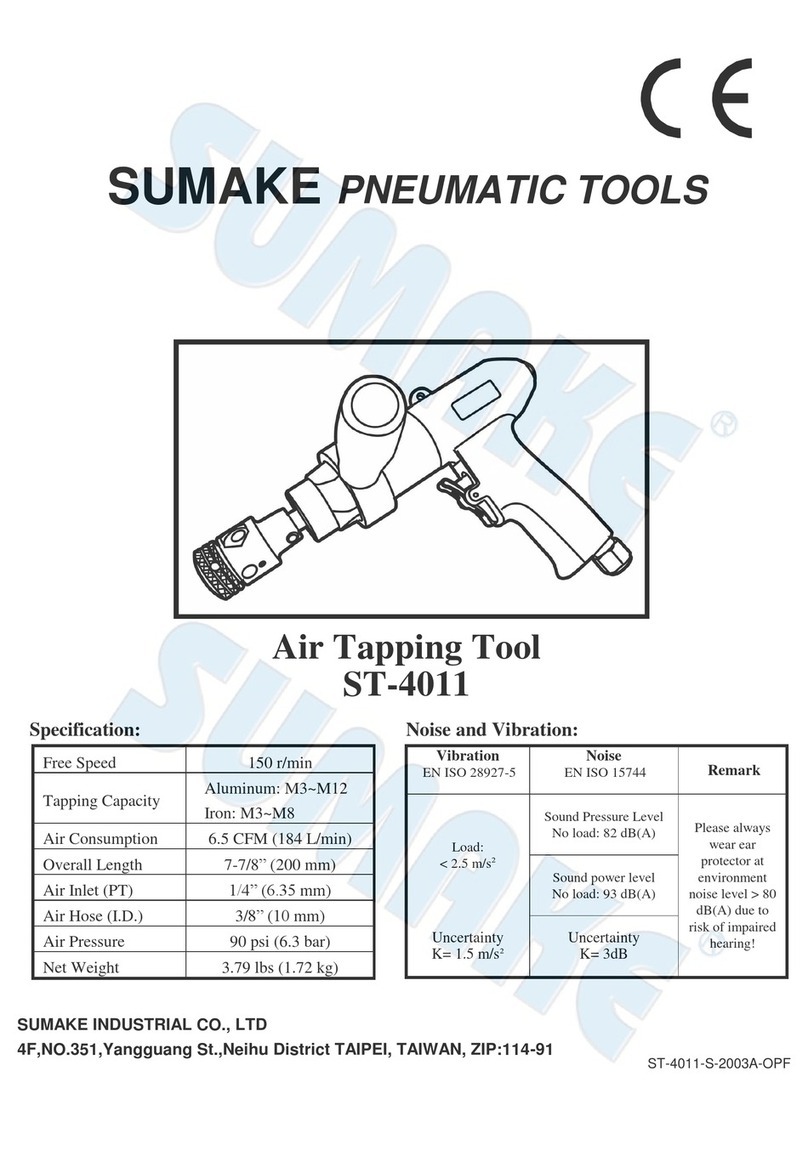
Sumake
Sumake ST-4011 manual

Parkside
Parkside PFRS 1.5 B3 operating instructions
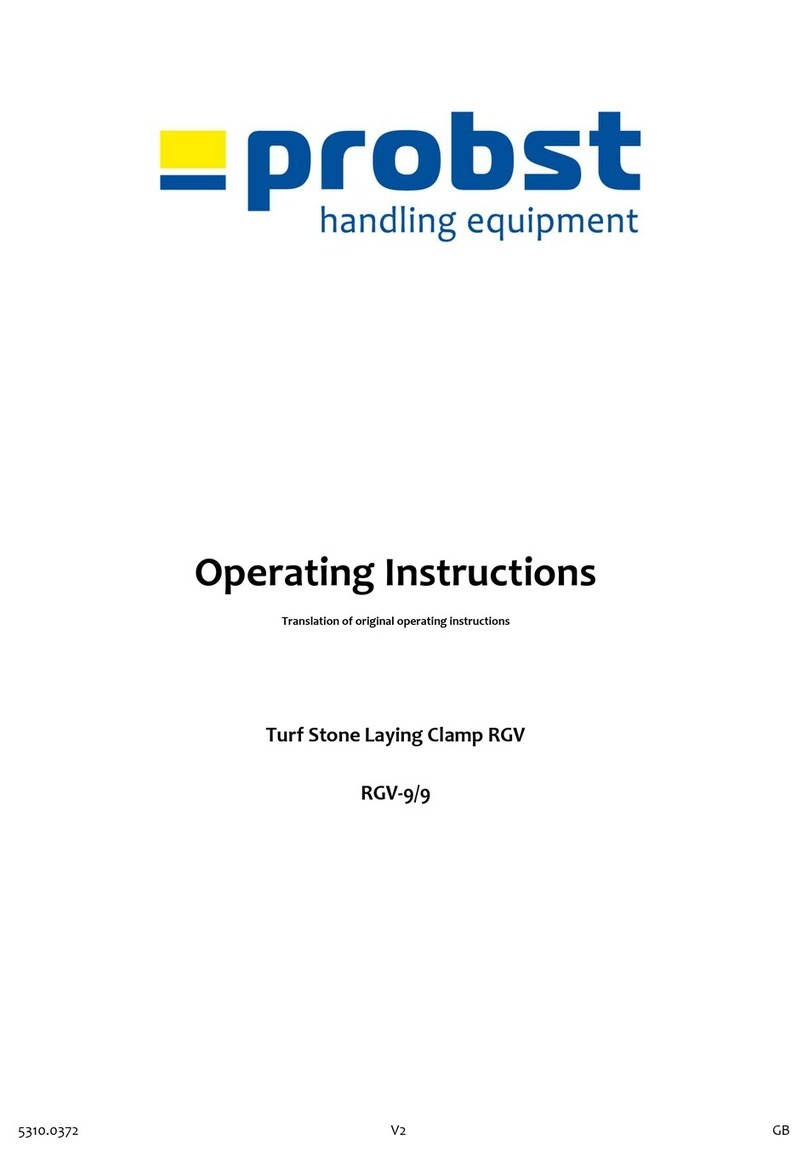
probst
probst 5310.0372 operating instructions
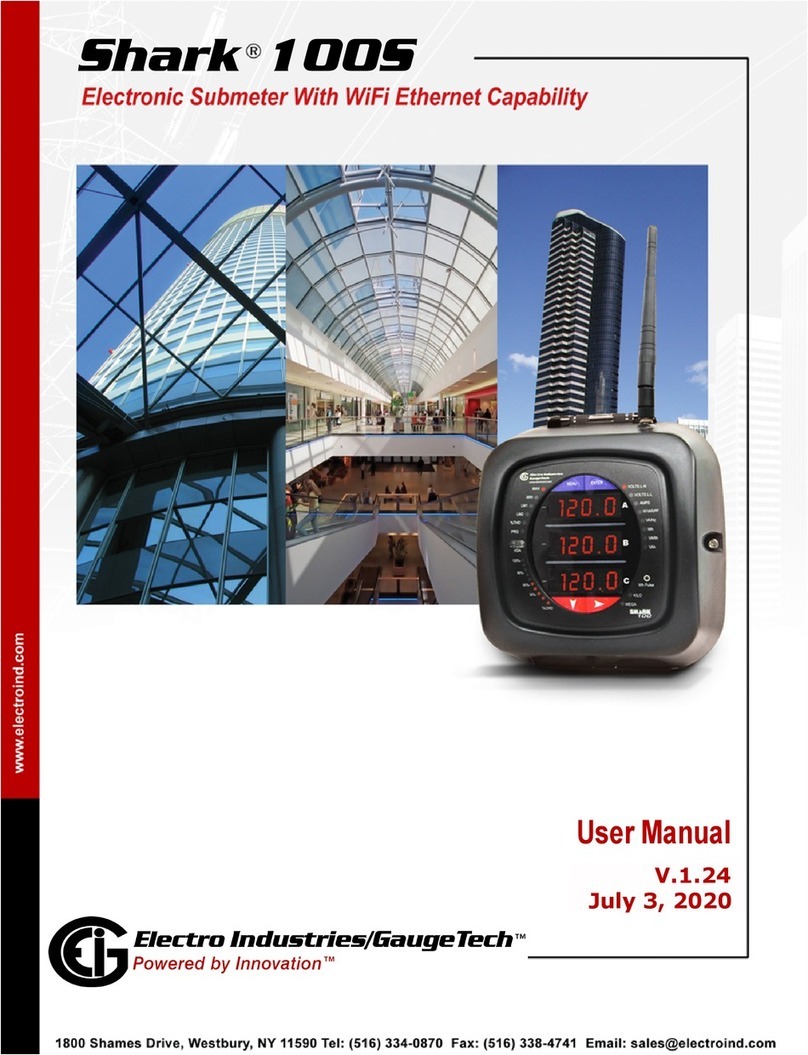
Electro Industries/GaugeTech
Electro Industries/GaugeTech Shark 100S user manual

AREBOS
AREBOS AR-HE-WK600P quick start guide
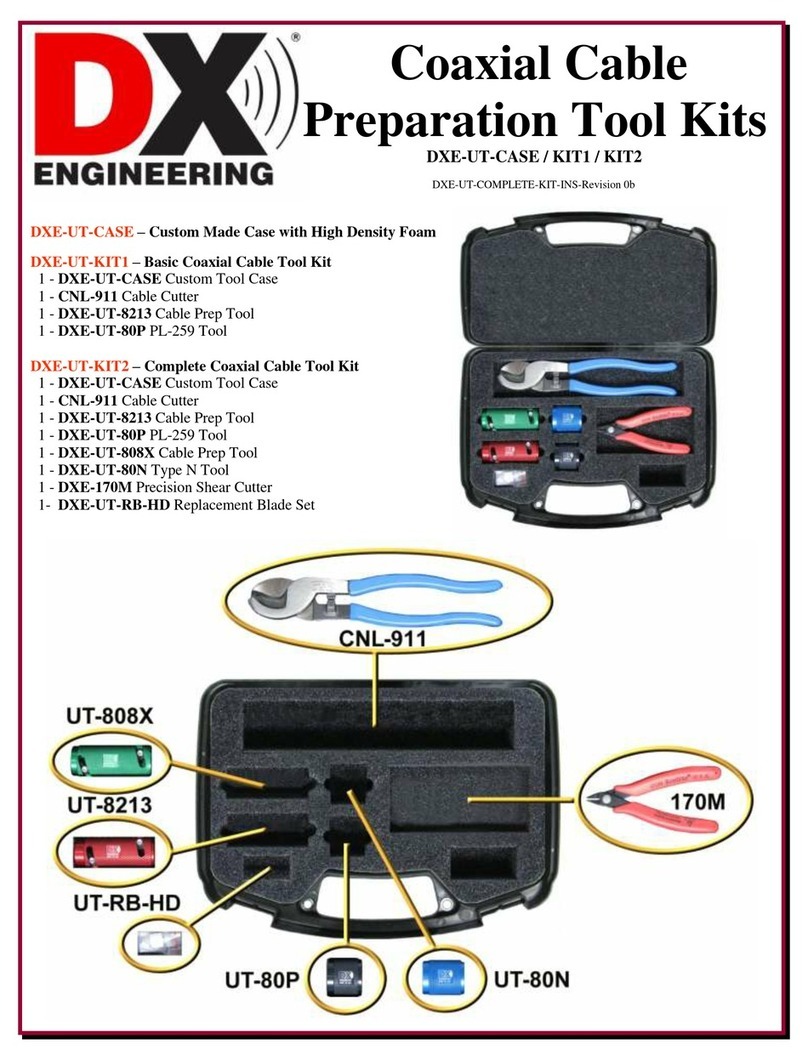
DX Engineering
DX Engineering DXE-UT-CASE KIT1 quick start guide
